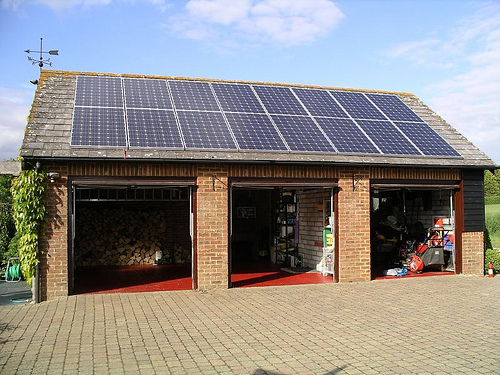Photo: Jaydee! Cross-posted from Climate Progress.
Clean energy professionals often complain that solar photovoltaic (PV) receives too much attention compared to other sectors like solar hot water, geothermal, and biomass. I’m sympathetic to that sentiment. But I also think the attention is deserved.
Solar PV is unique. Because manufacturing can scale so quickly and the technology can be deployed so rapidly on existing infrastructure, the rate of innovation in PV is arguably faster than in any other energy sector. The digital age has made us accustomed to constant change, which is probably one reason people get so impatient with the seemingly slow pace of change in the energy sector. The rate of change in PV most closely resembles what we see in the IT sector, which makes it a very compelling story.
And it’s not just journalists who are giving PV so much attention — it’s playing out in the business world as well. In 2011 alone, four major U.S. projects totaling 1,850 megawatts (MW) of capacity have switched from concentrated solar power (CSP) to PV because the economics of PV have changed so drastically, while the economics of CSP have changed more slowly. A recent Reuters story on the trend had some very telling quotes:
“The pace is quickening,” GTM Research analyst Brett Prior said of the numbers of projects making the switch to PV. “You can build a PV project all-in and it will cost less upfront and cost less ongoing. You will make more money on that project, and so it just makes sense to switch it.” …
“PV is available now and financeable now,” said Sean Gallagher, managing director of government and regulatory affairs for K Road Power. “The production of SunCatcher technology has been delayed for a couple of years. It can’t be deployed as soon as PV can be deployed.” …
“Our CSP is a little bit more restrictive,” [Edward Sullivan of Solar Millennium] said. “We have to develop 250-MW chunks, so that requires us to develop large continuous swaths, whereas PV is much more flexible.”
What is driving these changes? There is a lot of fascinating research and pre-commercial activity happening around plastic solar cells, inks, fibers, and other materials. But the most exciting innovations are coming from businesses finding new ways to manufacture, finance, package, sell, and install solar — all with today’s commercially available technologies.
We covered some of the factors in a post last month on “ferocious cost reductions” in the sector. In this post, we’ll break down a few of the pressure points that companies are addressing to continue driving those reductions.
Manufacturing
By the end of this year, we’ll have about 50 gigawatts (GW) of solar production capacity, according to Shayle Kann of GTM Research. That has caused a chronic oversupply of modules, driving down prices 50 percent in two years and forcing manufacturers to drop costs in sync. (The average selling price for solar PV modules is $1.50, and will likely fall to $1 by 2013.)
There’s some debate in the sector about how long companies will be able to push costs for silicon-based technologies downward. But Charlie Gay, a 35-year veteran of the solar industry who is president of Applied Solar, believes that silicon, which represents about 80 percent of the market, “is a very long way from being tapped out.”
Note: This data is already two years old.Image: Emanuel Sachs (MIT)
Every decade, he says, the thickness of silicon wafers have been cut in half while efficiencies have increased. He believes that companies can realistically reduce the thickness of wafers from 180 microns today all the way down to 50 microns while still maintaining efficiencies.
“The industry is just now moving into the second generation,” explains Gay, where manufacturers are using printed circuits, textured cells, different interconnect wires, better sawing techniques, and photoluminescence technologies to inspect cells at a higher throughput. “Crystalline silicon has a very long continuum of progress.”
Also nipping at the heels of conventional silicon are a variety of thin films that can be manufactured at an even lower cost — but also come with lower efficiencies.
First Solar has driven the cost of manufacturing cadmium-telluride thin films (which are about 15 percent of the market) to under 70 cents a watt; amorphous silicon thin-film equipment manufacturer Oerlikon says its customers have cut module production costs to well under a dollar, and are on a path to get below 70 cents a watt in the coming months; and CIGS producer Solar Frontier, which just opened a 1 GW facility for the high-efficiency thin film, says that its technology is competitive with leading thin film manufacturers.
However, due to low silicon prices and continued innovations in manufacturing, silicon-based module producers are closing in on the $1 per watt cost threshold, taking away some of the competitive advantages thin films have enjoyed.
This race to the bottom is happening fast. And it’s still heating up. “We are truly realizing what scale brings to an industry,” says Gay. “The pace of innovation is enormous and there’s still a ton of room for plenty more with these technologies.”
Hard costs: balance of systems and labor
Innovation in manufacturing is an important piece of the picture. But as module costs continue their steady decline, all the other components (racking, wiring, power electronics, labor) make up a greater share of the total system cost. A recent report from GTM Research shows that Balance of Systems (BOS) technologies will make up a majority share of a PV system’s cost in the next year, going from 44.8 percent of a utility-scale, crystalline-silicon PV system in 2010 to 50.6 percent in 2012.
Image: GTM research
That is pushing a lot of the pressure onto BOS manufacturers to drop their costs along with the module producers:
“The PV market has new focus,” said Shayle Kann, Managing Director of GTM Research’s solar practice. “While the module will remain the most costly single part of a PV system for the foreseeable future, the large combined cost of BOS components will inevitably engender greater activity and innovation across the BOS value chain. We expect to see BOS consolidation, integrated business models and increased supplier competition in the coming years as more companies see the BOS as a ma
jor revenue opportunity in the PV market.”
Recognizing this trend, the Rocky Mountain Institute put together a roadmap for BOS cost reductions, projecting that with current technologies and practices, the industry could reduce hardware costs from today’s price of $1.43 per watt for a utility-scale system to between 60 and 90 cents a watt within the next five years. The recent GTM Report shows a similar path, projecting a 29 cents per watt reduction by 2013.
On that trajectory — even without additional cost reductions in modules — achieving a levelized cost of energy (LCOE) for solar of 13 cents per kilowatt hour (kWh) across a wide range of U.S. of markets is within sight. And if we can get module prices down to 70 cents a watt (which is very realistic), an LCOE of 8 cents/kWh in the next four to five years is very attainable.
Soft costs: business and regulatory efficiencies
As solar businesses mature, they become more efficient at securing financing, managing projects, and navigating the regulatory environment. But there are still additional costs that can be wrung out here too. On the residential side, non-labor soft costs that come from generating leads, quoting projects, and processing incentive paperwork add up to $1 per watt — and about half of that can come from permitting.
Image: Institute for Local Self Reliance
The solar-services company SunRun has been on a mission to streamline residential solar permitting and inspection around the U.S. With around 50 cents a watt for a 5 kW system going toward permitting, that adds about $2,500 onto the final cost. SunRun has been pushing hard [PDF] for federal standards around permitting, which the company says could potentially open up solar services to half of American households.
Local permitting and inspection processes are the bane of the solar industry, and costs are falling at a glacial pace. Certain installers experience this cost rising, and some even refuse to sell in certain jurisdictions that have especially cumbersome processes. These costs are unnecessary and counterproductive, and streamlining will support safety through efficiency and repetition.
SunRun CEO Ed Fenster has been working closely with the government on the issue, saying that Department of Energy (DOE) Secretary Steven Chu “gets it” and believes “we can get to where we need to go, even though most of the attention seems to be on technology.”
Under the DOE’s recent Sunshot Initiative, which aims to reduce solar costs by 75 percent by 2020, $12.5 million has been set aside to encourage local governments to compete with one another around developing streamlined plans for permitting. Another $15 million will be put toward zoning and interconnection regulations.
In the meantime, there have been a few recent changes on the state level, which Fenster says have been “promising but come with plenty of tension. Permitting fees are precious.” In Colorado, the governor signed a bill last month that makes permitting easier and caps fees for solar PV and solar hot water systems. Vermont also recently put in place an easy permitting procedure. These were two key victories for the solar industry, but the rest of the permitting landscape across the U.S. is still incredibly scattered.
The permitting and regulation issue is an easy fix for the industry that could provide a major leap downward for the installed cost of solar systems. In Germany, for example, the average cost of a system is about 40 percent cheaper due to a better permitting process: “It’s all about local permitting. It’s amazing how much impact this can have — there’s no reason why we shouldn’t be able to do the same thing they’ve done,” says Fenster.
The road to cost reductions: we’re already on it
These examples don’t begin to cover all the innovations in technology, financing, and business development that are driving down the cost of solar electricity today. But they offer some of the highest potential for improving the economics of PV.
The cumulative impact of these cost reductions is enormous — we’re talking about stripping multiple dollars from a system’s cost in a very short period of time, bringing us to a price of electricity that is potentially very competitive in many areas of the country, not just in the Southwest and California. These dramatic changes aren’t coming from early-stage technologies in labs, they are coming from today’s businesses that are reaching a new level of maturity.




